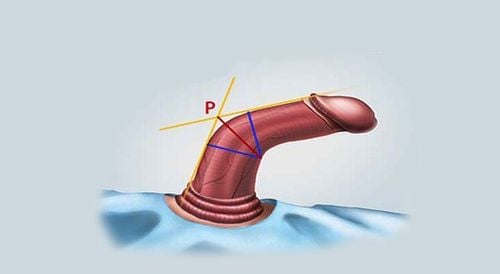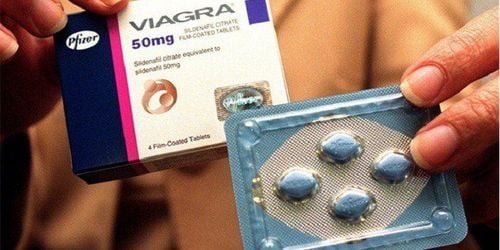This is an automatically translated article.
The article was professionally consulted with Specialist Doctor I Nguyen Hung - Doctor of Endocrinology - Department of Medical Examination & Internal Medicine - Vinmec Danang International General Hospital.Cavernous sclerosis is a growth of fibrous tissue inside the cavernous penis, which curves and deforms during erection. The progression of cavernous sclerosis can cause significant pain in some men, and even lead to guilt and stress during sex.
1. What is cavernous sclerosis?
Cavernous sclerosis (Peyronie's disease) is defined as the presence of fibrous plaques or hardening of the penis in the penis. The place where these fibrous plaques appear and develop is in the corpus cavernosum - essentially the erectile tissue of the penis, which helps the penis increase in size and diameter during sex.If the fibrous plaque forms and proliferates on the dorsal side of the penis, it will cause the penis to curve upwards and vice versa, if it is on the abdomen, it will make the penis bend downwards. In rare cases, fibrous plaques can also be found on both the upper and lower sides, causing the penis to convex and shorten the length when erect.
Cavernous sclerosis is completely benign, often progresses slowly over time and manifests from mild to severe, making it difficult for men to have sex. Therefore, this can also be the cause of depression and anxiety in men. However, many cases of the disease can be self-resolved and completely cured.
2. Manifestations of cavernous sclerosis
The signs and rates of progression of plaque formation in cavernous sclerosis, which causes complaints in patients, vary from person to person. Even so, the most common symptoms are listed as follows:Scar tissue: Scar tissue thickens into plaques on the cavernous body that can be felt by the man himself just under the skin of the penis. This structure is often described as a flat lump or band of hard tissue. Penile deformity: Fibrous plaques cause the penis to flex, most noticeable during erection. The penis can be curved upward, downward, or bent to either side. In some cases, the penis when erect is reduced to an "hourglass" shape. In addition, the penis may be shorter than before. Erectile dysfunction: Men find that their ability to control an erection is no longer as good as it once was, either in initiating or maintaining an erection. Pain: The fibrous plaques grow, causing shrinkage and compression, causing a man to experience penile pain with or without an erection. In which, if the disease regresses on its own, pain during erection will gradually improve within one to two years; however, curvature and distortion may remain.

3. Causes of cavernous sclerosis
The cause of cavernous sclerosis is still unclear. However, there are some observations that show an association with some of the following factors.The most common hypothesis is that cavernous sclerosis is the result of repeated trauma to the penis. For example, the penis can be damaged during sex, sports or after an accident... However, the evidence to support this hypothesis is still limited.
In addition, if a man has one of the following risks, the chances of developing cavernous sclerosis are increased:
Genetics: If a man's father or brother has had the disease, he or she is at increased risk. chance of getting this disease. Connective Tissue Disorders: Male patients with a history of connective tissue disorders appear to be at increased risk for progression to cavernosal sclerosis. The evidence is that when examining some men with the disease, they will find that their palms have very thick fibrous bands, causing the fingers to be pulled inward. Age: The incidence increases with age, especially in men over 55 years of age. Other factors: Some health conditions such as smoking, prostate surgery, urogenital surgery... may be related to the disease.
4. Complications of cavernous sclerosis
Complications of cavernous sclerosis include:Inability to have sex spontaneously Difficulty achieving or maintaining an erection (erectile dysfunction) Anxiety or stress about sexual performance Relationship stress with partner Male infertility due to inability to have intercourse.
5. How to diagnose cavernous sclerosis?
In the majority of cases, the presence of scar tissue in the penis during normal and erection, together with the above manifestations, is sufficient to diagnose cavernous sclerosis. .Doing some extra clinical diagnostics will become useful. For example, your doctor may order an ultrasound or general imaging test to examine the penis for an erection. Before taking pictures of the penis, patients sometimes need to inject drugs directly into the penis to help it get erect.
Of these, ultrasound is the most commonly used test for abnormalities in the penis. The principle of ultrasound is to use sound waves to create images that reflect the structure of soft tissues. At this point, an ultrasound will reveal the presence of scar tissue, blood flow to the penis, and any other structural or structural abnormalities.

6. Treatment of cavernous sclerosis
Because in most cases, cavernous sclerosis goes away on its own. Therefore, the doctor will delay the treatment, only advise and guide the patient on how to monitor if the curvature of the penis is really not too serious, there is no worsening, or the patient is still good erection and sex without pain or only mild pain.Conversely, if symptoms become severe and worsen over time, your doctor may recommend medication or surgery.
Some drugs have been applied to treat cavernous sclerosis, but the effectiveness is still limited and inconsistent among different groups of subjects. In particular, the drugs used have the main mechanism to help break down collagen accumulation, destroy or prevent the formation of fibrous bands and plaques in the cavernous body. These drugs are available in oral, topical or injection form directly into the penis. Besides, to increase the effectiveness of internal treatment, the patient may be prescribed more pain relievers and local anesthetics during sex, making the process more comfortable. , surgical methods on cavernous sclerosis showed more satisfactory results. Your doctor may recommend surgery if the deformity of the penis is severe, causing discomfort or preventing sexual intercourse. Because cavernous sclerosis can regress on its own, surgical intervention is not recommended when the patient has had the condition for less than a year or the curvature of the penis has stopped increasing and is stable for more than six months.
The type of surgery performed will depend on the condition, the location of the scar tissue, the severity of the symptoms, and other factors. The main principle is to remove scar tissue, reconstruct the shape of the penis, if there is a shortage of tissue, take autologous tissue from the patient's own body or artificial graft. Depending on the type of surgery, you may be able to go home the same day. However, having sex should be delayed for the first four to eight weeks.
In addition, there are a number of other treatment methods in cavernous sclerosis that are still being researched and gradually evaluated for effectiveness such as using electric currents, sound waves to break up scar tissue, prolonged therapy penis and even radiation therapy...
Cavernous sclerosis causes penis deformity, pain during sex is the worry of many men. Therefore, when having one of the above-mentioned signs, a man needs to choose a reputable gynecology and urology specialist to examine and plan early treatment to ensure male bravery and enjoy happiness. couple.
Please dial HOTLINE for more information or register for an appointment HERE. Download MyVinmec app to make appointments faster and to manage your bookings easily.
References: mayoclinic.org, webmd.com, urologyhealth.org, emedicine.medscape.com, niddk.nih.gov, healthline.com














